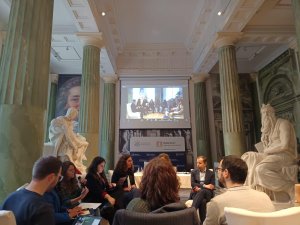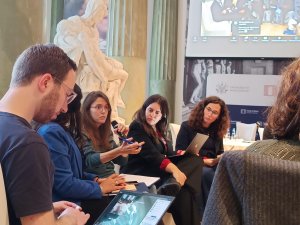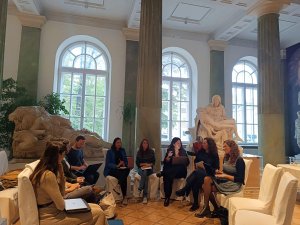From stone to classroom: new didactics in teaching epigraphy – relacja z konferencji
From stone to classroom: new didactics in teaching epigraphy - relacja z konferencji
6 października 2025 r. zespół projektu STONE-MASTERS zorganizował konferencję dydaktyczną poświęconą nauczaniu epigrafiki łacińskiej. Wiodącą rolę w konferencji odegrała dr Marina Bastero Acha. Uczestnicy z różnych instytucji akademickich w Europie podzielili się swoimi doświadczeniami w zakresie dydaktyki, cyfrowego opracowywania inskrypcji oraz ich wykorzystania w pracy z dziećmi, młodzieżą w szkołach podstawowych i ponadpodstawowych, młodymi dorosłymi i studentami. Program obejmował referaty poświęcone narracji epigraficznej, edukacji szkolnej i strategiom skierowanym do szerokiego grona odbiorców, a także dyskusję panelową.
Konferencję otworzył referat Krystyny Stebnickiej o tradycjach dydaktycznych Zakładu Historii Starożytnej Wydziału Historii UW ze szczególnym uwzględnieniem podwalin pod tradycje Zakładu położonych przez prof. Izę Bieżuńską-Małowist i prof. Ewę Wipszycką-Bravo.
Pozostałe referaty wygłosili:
- Chiara Cenatti (University of Vienna), A Fabulous (Hi)story: Epigraphic Storytelling with Children
- Cristina de la Escosura Balbás (Universidad de Alcalá (UAH), Madrid), “All the School Kids so Sick of Books. When the Buzzer Rings…” They’re Writing like a Roman: Epigraphy for Secondary Education
- Jonatan Pérez Mostazo (University of the Basque Country) oraz Marina Bastero Acha (University of Warsaw), Unveiling Roman Society through Inscriptions: A Didactic Exploration in Basque Secondary Education
- Elena Duce Pastor (Universidad Autónoma de Madrid), How to Tell a Good Story with Digital Epigraphy and Social Networks: A Story-Telling Project for Master Students
- Beatrice Luci (Università di Roma “La Sapienza”), From Stone to Pixel: Digital Strategies to Disseminate Medieval Epigraphy in Italy
On 6 October 2025, the STONE-MASTERS project team organised an educational conference devoted to teaching Latin epigraphy. Dr Marina Bastero Acha played a leading role in the conference. Participants from various academic institutions in Europe shared their experiences in teaching, digital processing of inscriptions and their use in working with children, youths in primary and secondary schools, young adults and students. The programme included presentations on epigraphic narrative, school education and strategies aimed at a wide audience, as well as a panel discussion.
The conference was opened by Krystyna Stebnicka’s paper on the teaching traditions of the Department of Ancient History of the Faculty of History at the University of Warsaw, with particular emphasis on the foundations of the Department’s traditions laid by Prof. Iza Bieżuńska-Małowist and Prof. Ewa Wipszycka-Bravo.
Other presentations were given by:
- Chiara Cenatti (University of Vienna), A Fabulous (Hi)story: Epigraphic Storytelling with Children
- Cristina de la Escosura Balbás (Universidad de Alcalá (UAH), Madrid), “All the School Kids so Sick of Books. When the Buzzer Rings…” They’re Writing like a Roman: Epigraphy for Secondary Education
- Jonatan Pérez Mostazo (University of the Basque Country) and Marina Bastero Acha (University of Warsaw), Unveiling Roman Society through Inscriptions: A Didactic Exploration in Basque Secondary Education
- Elena Duce Pastor (Universidad Autónoma de Madrid), How to Tell a Good Story with Digital Epigraphy and Social Networks: A Story-Telling Project for Master Students
- Beatrice Luci (Università di Roma “La Sapienza”), From Stone to Pixel: Digital Strategies to Disseminate Medieval Epigraphy in Italy






